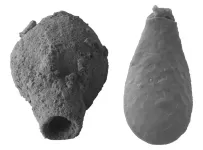(Press-News.org) An estimated one in five Americans live with chronic pain and current treatment options leave much to be desired. Feixiong Cheng, PhD, Director of Cleveland Clinic’s Genome Center, and IBM are using artificial intelligence (AI) for drug discovery in advanced pain management. The team’s deep-learning framework identified multiple gut microbiome-derived metabolites and FDA-approved drugs that can be repurposed to select non-addictive, non-opioid options to treat chronic pain.
The findings, published in Cell Press, represent one of many ways the organizations' Discovery Accelerator partnership is helping to advance research in healthcare and life sciences.
Treating chronic pain with opioids is still a challenge due to the risk of severe side effects and dependency, says co-first author Yunguang Qiu, PhD, a postdoctoral fellow in Dr. Cheng's lab whose research program focuses on developing therapeutics for nervous system disorders. Recent evidence has shown that drugging a specific subset of pain receptors in a protein class called G protein-coupled receptors (GPCRs) can provide non-addictive, non-opioid pain relief. The question is how to target those receptors, Dr. Qiu explains.
Instead of inventing new molecules from scratch, the team wondered whether they could apply research methods they had already developed for finding preexisting FDA-approved drugs for potential pain indication. Part of this process involves mapping out gut metabolites to spot drug targets.
To identify these molecules, the first author and computational scientist Yuxin Yang, PhD, a former Kent State University graduate student. Dr. Yang completed his thesis research in Dr. Cheng's lab and continues to work there as a data scientist. Drs. Yang and Qiu led a team to update a previous drug discovery AI algorithm the Cheng Lab had developed. Collaborators from IBM helped write and edit the manuscript.
“Our IBM collaborators gave us valuable advice and perspective to develop advanced computational techniques,” Dr. Yang says. “I'm happy for the opportunity to work with and learn from peers in the industry sector.”
To determine whether a molecule will work as a drug, researchers need to predict how it will physically interact with and influence proteins in our body (in this case, our pain receptors). To do this, the researchers need a 3D understanding of both molecules based on extensive 2D data about their physical, structural and chemical properties.
“Even with the help of current computational methods, combining the amount of data we need for our predictive analyses is extremely complex and time-consuming,” Dr. Cheng explains. “AI can rapidly make full use of both compound and protein data gained from imaging, evolutionary and chemical experiments to predict which compound has the best chance of influencing our pain receptors in the right way.”
The research team’s tool, called LISA-CPI (Ligand Image- and receptor's three-dimensional (3D) Structures-Aware framework to predict Compound-Protein Interactions) uses a form of artificial intelligence called deep learning to predict:
if a molecule can bind to a specific pain receptor
where on the receptor a molecule will physically attach
how strongly the molecule will attach to that receptor
whether binding a molecule to a receptor will turn signaling effects turn on or off
The team used LISA-CPI to predict how 369 gut microbial metabolites and 2,308 FDA- approved drugs would interact with 13 pain-associated receptors. The AI framework identified several compounds that could be repurposed to treat pain. Studies are underway to validate these compounds in the lab.
“This algorithm’s predictions can lessen the experimental burden researchers must overcome to even come up with a list of candidate drugs for further testing,” Dr. Yang says. “We can use this tool to test even more drugs, metabolites, GPCRs and other receptors to find therapeutics that treat diseases beyond pain, like Alzheimer’s disease.”
Dr. Cheng added that this is just one example of how the team is collaborating with IBM to develop small molecule foundation models for drug development – including both drug repurposing in this study and an ongoing novel drug discovery project.
“We believe that these foundation models will offer powerful AI technologies to rapidly develop therapeutics for multiple challenging human health issues,” he says.
Study Info:
This is a collaborative project with Dr. Qiang Guan from Kent State University, and Dr. Jianying Hu and Dr. Michal Rosen-Zvi from IBM.
END
Researchers seek to improve advanced pain management using AI for drug discovery
The artificial intelligence algorithm identified multiple gut metabolites and FDA-approved drugs that have potential to be repurposed as non-addictive, non-opioid pain medications
2024-10-04
ELSE PRESS RELEASES FROM THIS DATE:
‘Neutron Nexus’ brings universities, ORNL together to advance science
2024-10-04
Oak Ridge National Laboratory has launched its Neutron Nexus pilot program with Florida Agricultural & Mechanical University, or FAMU, and Florida State University, or FSU, through the FAMU-FSU College of Engineering. The first program of its kind nationwide, it’s aimed at broadening and diversifying the scientific user community with outreach to universities and colleges to increase collaboration and, ultimately, scientific advancement.
Although a recently planned two-day “ORNL Days” event in Florida was cut ...
Early release from NEJM Evidence
2024-10-04
This article was published Early Release to coincide with a presentation at the Symposium on Advanced Wound Care in Las Vegas, NV.
Full text is now available on evidence.nejm.org. Email mediarelations@nejm.org for access.
Original Article: Intact Fish Skin Graft to Treat Deep Diabetic Foot Ulcers
Dured Dardari, M.D, Ph.D., From the Diabetology Department, Center Hopitalier Sud Francilien, Corbeil-Essonnes, France, and the LBEPS, Université d’Evry, IRBA, Université Paris Saclay, 91025 Evry, France.
If you have any questions for our office, please contact our Media Relations ...
UMass Amherst astronomer leads science team helping to develop billion-dollar NASA satellite mission concept
2024-10-04
October 4, 2024
UMass Amherst Astronomer Leads Science Team Helping to Develop Billion-Dollar NASA Satellite Mission Concept
Alexandra Pope, science lead for the PRIMA space telescope, is on team developing next-generation space probe that will explore evolution of the universe
AMHERST, Mass. – A University of Massachusetts astronomy professor is science lead on a $5 million proposal selected by NASA to develop new space satellite missions that bridge gaps in our understanding of the evolution of ...
Cultivating global engagement in bioengineering education to train students skills in biomedical device design and innovation
2024-10-04
International collaboration between the Bioengineering Department at Clemson University, South Carolina and Arusha Technical College in Tanzania will further enhance development of a workforce skilled in biomedical device design and innovation. A recent National Science Foundation grant awarded to Dr. Melinda Harman, an Associate Professor at Clemson, along with her team of collaborators will develop innovative approaches to problem-based learning in bioengineering while fostering breakthroughs that address global health ...
Life on Earth was more diverse than classical theory suggests 800 million years ago, a Brazilian study shows
2024-10-04
About 800 million years ago (mya), before the supercontinent Pangea formed, the Earth was more diverse than classical theory suggests. By reconstructing the tree of life from the evolutionary history of amoebas and the ancestors of algae, fungi, plants and animals, Brazilian researchers have created a scenario in which several different lineages of many species inhabited the planet during the period. An article reporting their findings is published in Proceedings of the National Academy of Sciences of the United States of America (PNAS).
According to the literature, several lineages of eukaryotes that first emerged 1.5 billion years ago diversified and ...
International clean energy initiative launches global biomass resource assessment
2024-10-04
A multi-country, government-led initiative dedicated to advancing the global transition to a sustainable, bio-based economy, unveiled a new Global Biomass Resource Assessment, providing groundbreaking data on current and future sustainable biomass supplies around the world.
The results from this new global sustainable supply assessment will allow scientists, policymakers, and industry leaders to explore potential sources of biomass as a foundation for a circular and sustainable global bioeconomy, supporting ...
How much do avoidable deaths impact the economy?
2024-10-04
Two new papers in Nature Medicine by a global research team highlight the economic value of reducing avoidable deaths.
The first paper "applies novel methods to estimate the economic value of reducing avoidable deaths worldwide, finding that in 2019, 40 million deaths were avoidable—i.e., could have been prevented or delayed if individuals in all countries had access to the best available healthcare. The economic value of reducing these avoidable deaths is equivalent to 23% of annual global income, suggesting that ...
Federal government may be paying twice for care of veterans enrolled in Medicare Advantage plans
2024-10-04
PROVIDENCE, R.I. [Brown University] — From 2011 to 2020, the Veterans Health Administration spent $78 billion to care for U.S. military veterans enrolled in Medicare Advantage plans, raising questions about federal overpayments to those private plans.
That’s according to an analysis by researchers from Brown University and the Providence Veterans Affairs Medical Center. Published in JAMA, the study notes that because Medicare Advantage plans receive fixed per-patient payments for health care services without having payments reduced when veterans receive care ...
New therapeutic target for cardiac arrhythmias emerges
2024-10-04
A new study by researchers at the University of Arizona College of Medicine – Phoenix and the University of California Davis Health identified a new target for developing a therapy to treat atrial fibrillation, the most common type of abnormal heart rhythm.
Atrial fibrillation, commonly called AFib or AF, causes about 1 in 7 strokes, according to the U.S. Centers for Disease Control and Prevention, and is associated with a significant increase in the risk of morbidity and mortality. More than 12 million people are expected to have AFib by 2030, according to the American Heart Association, and current treatment ...
UC Irvine researchers are first to reveal role of ophthalmic acid in motor function control
2024-10-04
Irvine, Calif., Oct. 4, 2024 — A research team from the University of California, Irvine is the first to reveal that a molecule in the brain – ophthalmic acid – unexpectedly acts like a neurotransmitter similar to dopamine in regulating motor function, offering a new therapeutic target for Parkinson’s and other movement diseases.
In the study, published in the October issue of the journal Brain, researchers observed that ophthalmic acid binds to and activates calcium-sensing ...
LAST 30 PRESS RELEASES:
Practical education: Clinical scenario-based program development
The impact of family dynamics on eating behaviour – how going home for Christmas can change how you eat
Tracing the quick synthesis of an industrially important catalyst
New software sheds light on cancer’s hidden genetic networks
UT Health San Antonio awarded $3 million in CPRIT grants to bolster cancer research and prevention efforts in South Texas
Third symposium spotlights global challenge of new contaminants in China’s fight against pollution
From straw to soil harmony: International team reveals how biochar supercharges carbon-smart farming
Myeloma: How AI is redrawing the map of cancer care
Manhattan E. Charurat, Ph.D., MHS invested as the Homer and Martha Gudelsky Distinguished Professor in Medicine at the University of Maryland School of Medicine
Insilico Medicine’s Pharma.AI Q4 Winter Launch Recap: Revolutionizing drug discovery with cutting-edge AI innovations, accelerating the path to pharmaceutical superintelligence
Nanoplastics have diet-dependent impacts on digestive system health
Brain neuron death occurs throughout life and increases with age, a natural human protein drug may halt neuron death in Alzheimer’s disease
SPIE and CLP announce the recipients of the 2025 Advanced Photonics Young Innovator Award
Lessons from the Caldor Fire’s Christmas Valley ‘Miracle’
Ant societies rose by trading individual protection for collective power
Research reveals how ancient viral DNA shapes early embryonic development
A molecular gatekeeper that controls protein synthesis
New ‘cloaking device’ concept to shield sensitive tech from magnetic fields
Researchers show impact of mountain building and climate change on alpine biodiversity
Study models the transition from Neanderthals to modern humans in Europe
University of Phoenix College of Doctoral Studies releases white paper on AI-driven skilling to reduce burnout and restore worker autonomy
AIs fail at the game of visual “telephone”
The levers for a sustainable food system
Potential changes in US homelessness by ending federal support for housing first programs
Vulnerability of large language models to prompt injection when providing medical advice
Researchers develop new system for high-energy-density, long-life, multi-electron transfer bromine-based flow batteries
Ending federal support for housing first programs could increase U.S. homelessness by 5% in one year, new JAMA study finds
New research uncovers molecular ‘safety switch’ shielding cancers from immune attack
Bacteria resisting viral infection can still sink carbon to ocean floor
Younger biological age may increase depression risk in older women during COVID-19
[Press-News.org] Researchers seek to improve advanced pain management using AI for drug discoveryThe artificial intelligence algorithm identified multiple gut metabolites and FDA-approved drugs that have potential to be repurposed as non-addictive, non-opioid pain medications



